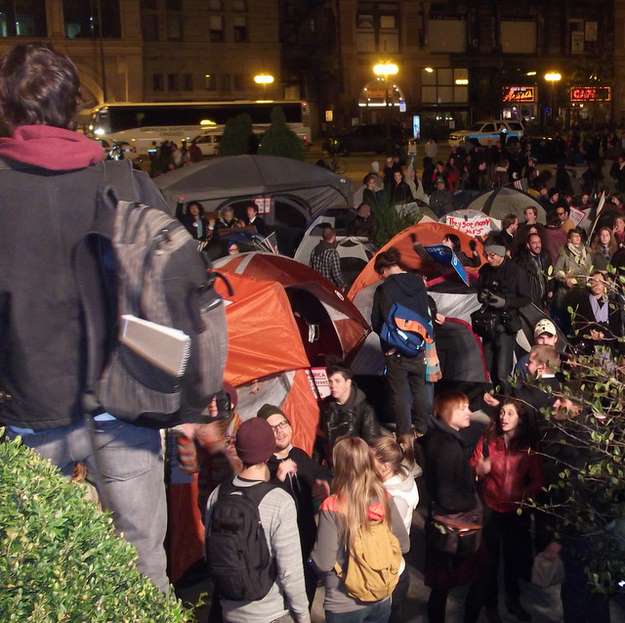Occupy Chicago Attempts to Occupy
By aaroncynic in News on Oct 17, 2011 6:00PM
Occupy Chicago decided during a Friday General Assembly meeting to attempt to formally make a permanent home in Congress Park on Michigan Avenue. After weeks of a “mobile occupation,” activists decided to enter into what they called "Phase 3," another a show of solidarity with those in Zucatti Park in New York, as well as an opportunity to have a more permanent base of operations.
By 2 p.m. Saturday nearly 500 demonstrators had assembled on three corners at Jackson and LaSalle. Teach-ins were held in the plaza below the Board of Trade and, as the afternoon wore on, both people and supplies flowed in from all directions. Occupy Chicago even gained some star support for a time when Lupe Fiasco came down to show his support and donated walkie talkies, tents and more.
The crowd in front of the Federal Reserve swelled to more than 2,000 people by 6:30 p.m. as the march towards Congress Park began. As protesters streamed into the park, a sound system was set up in front of the horse statue while various activists from all walks of life spoke. Others set up about two dozen tents at the foot of the horse. Police managed to take down one tent as it was being set up on the outskirts of the rally, but the sheer amount of demonstrators in the park made it impossible to get to the center where the main camp went up.
At 11 p.m., Chicago Police gave an order to disperse via loudspeaker. When they realized no one in the park could hear the order, a police commander headed towards the center of the forum and used the “people's microphone,” a procedure where all demonstrators repeat what one speaker is trying to communicate to the crowd, to repeat the dispersal orders. More than 200 demonstrators decided to stay in the park and face voluntary arrest in an act of non-violent civil disobedience.
Throughout the evening, the mood swung like a pendulum from tense to celebratory. Even though many knew police would most likely break down the camp from the beginning, the act itself was enough to embolden the spirits of everyone present. Even as Chicago police pulled armfuls of zip ties from wagons, Occupy Chicago members stayed hopeful police would allow them to stay. Those who were not willing to risk arrest streamed across the street and stood in front of Roosevelt University to still show their support. Many of those arrested had only began coming to Occupy Chicago actions recently and the majority of those lead away had never committed non-violence civil disobedience before. As they were released from the station to cheers and hugs from fellow activists, many of the arrested stated they were ready to do it again.
Strategically speaking, the move to physically occupy an area for the long term was risky. Ultimately, having an actual home base would have allowed an additional space to spread the message, as well as give those willing to stay for long periods of time an opportunity to further their cause. Either way, Occupy Chicago plans to maintain a presence in front of the Federal Reserve, but knew from the beginning the city would not allow a camp on the street. The choice to occupy a park and peacefully be arrested shows the movement's continued commitment to non-violence and a willingness to attempt to work with police.
The weekend's events showed Occupy Chicago is not going anywhere. They proved they can increase their numbers. They showed they have a plan, long term goals, and that the day to day organizing they're doing is working. Even though it only existed for a few brief hours beneath the horse, the spirit of Camp Occupy carries on through the hearts and minds of each demonstrator who participated that night, and that spirit continues to grow and spread.
